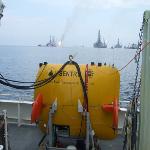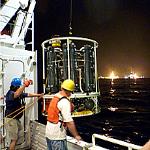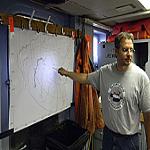20 August 2010

Photo: Dana Yoerger, Woods Hole Oceanographic Institution
The Sentry autonomous underwater vehicle (AUV) aboard the research vessel Endeavor at the Deepwater Horizon oil spill site.
Over a 10-day period in late June - two weeks before the damaged seafloor wellhead was successfully capped the researchers measured a massive plume near the wellhead site.
The oil plume was approximately 1,000 meters deep, 35 kilometers long, 200 meters high and 2 kilometers wide two months after the well explosion.
The team deployed an autonomous underwater vehicle, or AUV, and a sampling device tethered by cable to their ship on the surface. Researcher Chris Reddy says what they saw was a forensic snapshot showing that hydrocarbons can move into deep marine ecosystems.

C. McIntyre, Woods Hole Oceanographic Institution
Sampling device being lowered from the Endeavor research vessel."Our goal was to document a plume and see what its size, shape, distribution and eventually its chemical composition. This is an important aspect because there is very little known about oil in the sub-surface."
The AUV zigzagged its way through the oil plume to measure chemicals and biological activity at various depths.
The chemical analysis reported so far showed no substantial decay in the plume, which suggests that petroleum-eating microbes were not significantly breaking down the oil. Researcher Benjamin Van Mooy says that is in part because of water temperature.
"If everything else were equal same bugs, same oil, same nutrients, same oxygen. We would expect that the bacteria in the deep waters would be 10 times slower, just because it's cooler."?
Going nowhere fast
Florida State University oceanographer Ian MacDonald has studied the natural breakdown of spilled crude oil. He says that isn't happening as fast as had been hoped in the Gulf.
In a hearing before Congress Thursday, he disputed government claims that the oil in all its forms in the ocean is biodegrading quickly.

Ben Van Mooy, Woods Hole Oceanographic Institution
Chief Scientist Rich Camilli uses underwater mass spectrometers which are capable of identifying minute quantities of petroleum and other chemical compounds in seawater instantly."This oil has already degraded, evaporated and emulsified," said MacDonald. "It is going to be very resistant to further biodegradation. This oil is going to be in the environment for a long time."
Oceanographer MacDonald's testimony is in line with a report released this week by University of Georgia researchers finds that up to 79 percent of the oil that spewed from the broken well remains in the Gulf.
Scientists from Woods Hole hope that their data will help compile a more accurate picture of the deep ocean. They call for a sustained and coordinated research effort to better understand the impact of the spill and how best to respond to world's worst-ever maritime oil disaster.